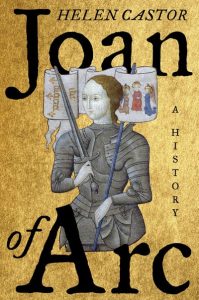From the Archives – Shin-kickers from History: Joan of Arc
Several months ago, I asked a group of family and friends to tell me what they knew about Joan of Arc, aka St. Joan, aka the Maid of Orleans–no stopping to look up the details. I needed to know how familiar the average smart, well-read, non-specialist is with her story.* The accuracy and detail of the answers varied, though everyone knew she was French and no one said “Joan who?” ** As I read the answers, one thing stood out: the people who remembered the most were all women who had been fascinated by her story at that age, somewhere between 9 and death, when smart girls look for historical role models to tell them that it’s okay to be tough/mouthy/opinionated/different.***
I was one of those girls. I’m still fascinated by Joan, and other warrior women. And I was delighted when two new biographies of the Maid of Orleans landed on my book shelves in recent months.
In Joan of Arc, historian Helen Castor returns to the subject of powerful medieval women that she explored so successfully in She Wolves. Castor brings a new twist to a familiar story, signaled in the use of “a history” rather than “a biography” as a sub-title. Instead of starting with Joan, she begins with the turbulent history of fifteenth century France, placing Joan’s achievements within the context of the bloody civil war that began with the assassination of Louis, Duke of Orleans, at the instigation of his brother, the Duke of Burgundy, in 1407. ****
Castor takes the reader step-by-step through the labyrinthine story of a France divided between Burgundians, the supporters of the French royal family, and the opportunistic claims of England’s Henry V to the French crown. Joan appears in the narrative one-third of the way through the book, when all hope of the French dauphin claiming his throne seems lost. Even after she appears, Castor never loses sight of the larger picture, placing Joan’s story within the context of previous French visionaries, politics within the French and English courts, and the realities of fifteenth century warfare.
Written with both scholarly rigor and the narrative tension of a historical thriller, Castor’s Joan of Arc makes the story of St. Joan more understandable, more complex, and more extraordinary. Or as cultural historian and mythographer Marina Warner put in in her own study of St. Joan: “so grand, so odd, so stirring.”
One of these days I’ll get to Kathryn Harrison’s Joan of Arc: A Life Transfigured. Then it will be time for compare and contrast.
* Note to self, next time you have this kind of question, post it on the blog. *Headsmack*
**My favorite answer captured the essence of the legend without reference to historical detail: “She was that sturdy girl that wore armor, carried a sword, fought the bad guys, stormed their castles, was burned at the stake for her troubles, and smiled while burning…thus Sainthood. ???????????”
***I’d love to think that modern pre-teens didn’t need these role models the same way we did in the Dark Ages before the women’s movement of the late 1960s and early 1970s, but I’m afraid it’s not true. Hence the popularity of the A Mighty Girl website and the #LikeAGirl campaign.
****That assassination was the subject of another book I loved, Eric Jager’s Blood Royal. Read together, the two books illuminate not only the period, but each other. It’s thrilling when that happens.





